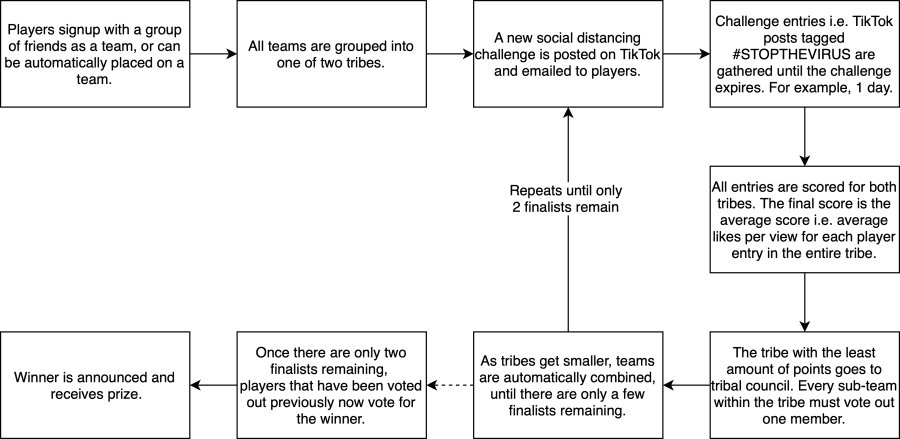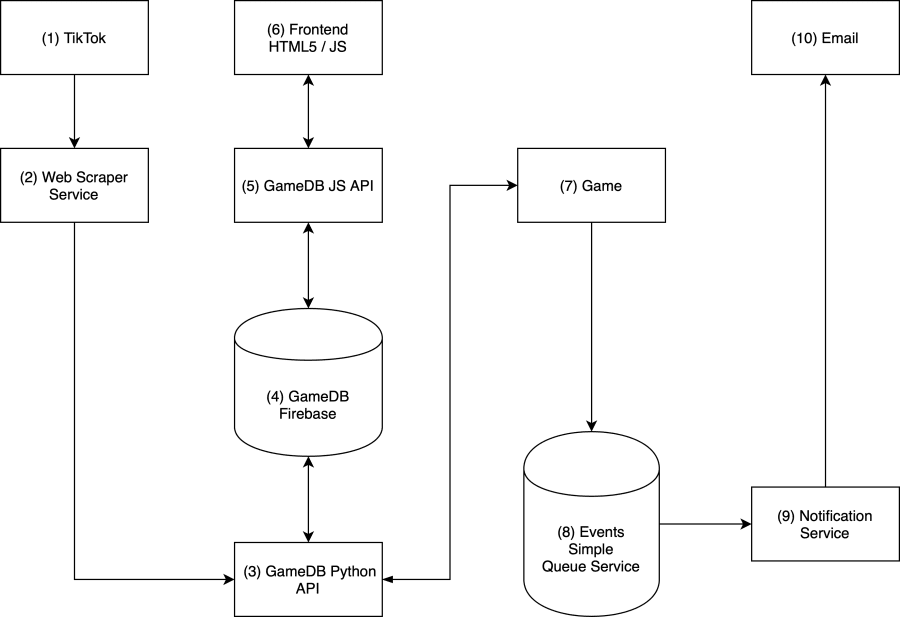#STOPTHEVIRUS

Inspiring the youth to stop COVID-19: can a global scale high stakes social game help inspire millions of Millennial and Gen-Z individuals across the world to engage in social distancing and stop the spread of the COVID-19 virus?
David Z, Brandon Tory, Bernard Baker, Daniel Francois, dl846
COVID-19 #STOPTHEVIRUS SOCIAL EXPERIMENT
Hypothesis:
Can a global scale high stakes social game help inspire millions of Millennial and Gen-Z individuals across the world to engage in social distancing activities and stop the spread of the COVID-19 virus?
Background:
It’s Spring 2020 and Coachella, SXSW, the NBA, NHL, MLB and the Tokyo Olympics are cancelled this year. We’re at the height of human technology and innovation, but at the same time facing one of the most devastating viral pandemics in history. The economy is suffering, countries around the world are facing mandatory lockdown orders and hospitals are overwhelmed. Despite this, many people are still unaware of the seriousness of COVID-19 and actions they can take to support our health care professionals such as social distancing to flatten the health care demand curve. Reducing the doubling rate of COVID-19 by even a few days can have massive impact. Can we use a high stakes social game to help inspire the youth to stop the virus?
This social game was inspired by the TV show Survivor (Watch before reading more). It's a game based on fun challenges, alliances and human psychology. The twist here is that instead of being stranded on a deserted island for 30 days, players are "stranded" inside their homes. This is important because social distancing, i.e. staying home, is the best tool that the youth have right now for collectively fighting the epidemic. All challenges in this game are designed to incentivize social distancing and spreading awareness. Simple activities like making home made cotton based masks can help reduce droplet based transmission rates by up to 70% and can be turned into social awareness challenges. Young and healthy people are at risk and can engage in activities that can increase risk for others, so the goal is to create home-based activities that reward risk mitigation.
Also, since the game is digital and based on social media, we aren't limited to the standard 20 players. Everyone can play. With the hope of attracting even more players and convincing them to socially distance, a donation is required to join and the winner takes all.
Here's how the game works:
Game Flow Chart

How to Win
New social distancing challenge ideas can be added continuously by the game admins. Some examples include Karaoke Challenge — Post a video doing your best lyric for lyric rendition of your favorite song. or Cleaning Challenge — Post a video showing your most creative way to clean your living space.
After thirty days a group of two finalists will have made it to the end. All previous players will have the opportunity to vote for who the winner of the prize money should be. Each finalist will be able to make a case on social media using a video post to say why they should be the final survivor and winner of the prize money.
Architecture Block Diagram

Requirements
pip3 install -r requirements.txt
Unit Tests
Running the unit tests is a good way to get started with development. In general, a technical goal here is to minimize the number of dependencies as much as possible.
To run the unit tests:
python3 -m unittest -v
To continuously run unit tests in a console window as you code:
Install entr
brew install entr
find . -name '*.py' | entr python3 -m unittest game_test.py -v
Design
Data Model
| Type | Properties | Comments |
|---|---|---|
| Game | id, count_players/teams/tribes | Counters for Firestore. |
| Player | id, tiktok, email, tribe_id, team_id, active | |
| Vote | id, from_id, to_id, team_id, is_for_win | |
| Team | id, name, tribe_id, active, count_players | |
| Tribe | id, name, active, count_players/teams | |
| Challenge | id, name, message, start/end_timestamp, complete | Posted by game admin(s) |
| Entry | id, likes, views, player_id, team_id, tribe_id, challenge_id, url | i.e. TikTok post |
Game and Event Model
The game architecture is comprised of a thin frontend (6) and a simple backend microservice (7) processing realtime events through Firebase (4) at scale. The frontend is intentionally thin and only used to display challenge information, perform signup and for player voting.
When challenges start each day, players submit their entry by simply posting to TikTok using the hashtag #STOPTHEVIRUS. The scraper service (2) will automatically search for entries from all participants and submit the relevant metrics (likes, views etc.) to the game database (4). As the game engine (7) processes each challenge and tribal council, events are submitted to a queueing service (8) so that notifications can be processed asynchronously at scale and delivered to players via email (10).
The initial proposed components are enumerated here:
TikTok
Web scraper service - a simple Python job that can run in a cluster in order to read TikTok post metadata and submit it to the game database (4). Due to API rate limiting the thought here is to use the HTTP endpoint rather than the REST API (TBD). If the API is unworkable players may need to submit challenge entry links using the frontend (6) as a fallback.
A Python interface for performing game queries and updates in Firebase for use from the backend (7).
A Firebase Cloud FireStore instance for hosting and processing realtime game data.
A JavaScript interface for performing game queries and updates in Firebase for use from the frontend (6).
A thin HTML5 / JavaScript (possibly React) app for player registration, voting and informational updates.
A Python microservice hosted on Firebase Functions that runs the core game loop and issues events.
A scalable AWS SQS queueing service for asynchronously processing game events. This is probably available with Firebase as well, haven't looked into it yet.
A simple job that can run in a cluster in order to read events from the queue (8) and perform bulk notifications to users via SMTP (SMS if anyone wants to integrate Twilio).
Getting Started with Development
All contributions are appreciated here and there's no contribution too small. The typical development flow here is:
Clone the repo:
git clone https://github.com/un7c0rn/stopthevirus.git
Create a local development branch:
git branch my_dev_branch_name
git switch my_dev_branch_name
Run the unit tests to make sure things pass before you start:
python3 -m unittest -v
Check the issues list.
If you see some work or on the issues list that matches your experience or is something you'd like to learn more about, comment on the thread and jump in. After writing your code and running the unit tests, create a pull request:
git commit -m "my new changes"
git push
Use the GitHub UI to compare changes and submit a pull request.
Leadership is appreciated here. If you have a design idea or improvement in mind just do it and send the pull request. Unit tests are key to working collaboratively since they ensure that changes don't cause new problems. As long as we have passing tests, changes are strongly encouraged. Feel free to submit PR's and add tests after the initial code review.
You may notice that the Firestore database credentials are included here in source control. This means that you can run your code against a real database instance without having to set one up. I think this is important especially for frontend development. The credentials are for a test-only public facing instance, a new prod instance will be deployed before the game goes live.
This is a collaborative effort that cannot be completed alone. It's important to have a diverse group of perspectives, ideas and skills to bring this together and create impact. No pull request is too small. Seeking both code and simple graphic asset / design ideas for frontend.
Scalability
Equations are included below for reference but the TL;DR here is that one monolithic million player game would cost about $10,000 in server fees and take 60-75 days to get down to one winner since each challenge takes 1 day. The cost could be covered by entry donations but the time seems way too long. It would also be extremely hard to get the game started since no one could start playing until millions of people had joined. For these reasons, in order to maximize impact the game will be sharded. Many games can be played in parallel, all with varying sizes. Players that want to try the game and engage in distancing activities can be placed into game settings that optimize for time (smaller number of players) and players that want to compete with lots of people can be placed into games that optimize for size i.e. waiting for the most participants. When a player is voted out they can join a new game which hopefully keeps the social distancing activities going for an even longer amount of time and increases fun, awareness and social impact for all.
Contact: brandon@formless.la